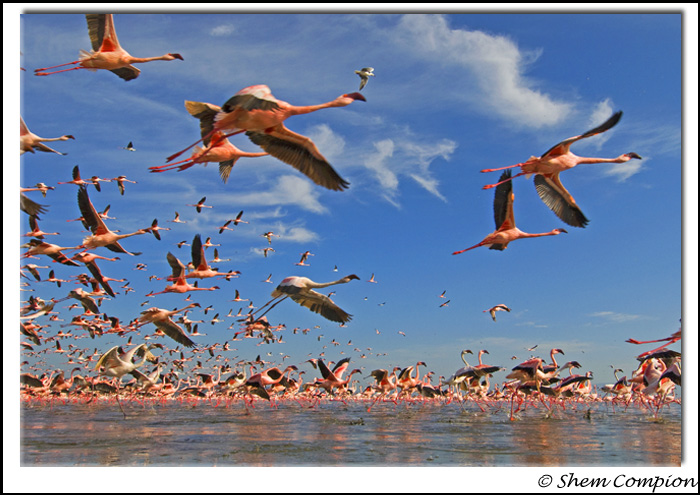Lake Nakuru has to be one of the most inspiring birding spectacles in the world. 60 000 thousand flamingos are a sight to behold. The noise, the smell and the constant movement and motion all combine to attack the senses in one large flock. I recently spent three nights with clients at this wonderful venue, with the express purpose of capturing these, and the many other birds here, in all their beauty.
Now that may sound like a simple thing to do- 60 odd thousand birds are more than enough subjects to fill a camera: Nevermind spending three days there. Well, it’s not as easy as that. These birds just don’t leave each other alone! The old phrase of “safety in numbers” is very true with these birds. They are very wary of any approach and tend to huddle together as more disturbance comes along. The best method of approach is that of patience. In the 30-degree heat on an open mud flat, that can be quite a task! However, we persevered through the heat and discomfort and all managed to come home with some fairly stonking images.
It has to be said though; Nakuru has not been all good news for the last few years. Only after flamingo numbers drastically dropped, did the Kenyan Wildlife Services start doing something about the problem. I wont go into it here, but expect a blog entry about it soon- as I consider the Flamingo a great indicator species. Happily though the numbers are back and tourists can enjoy these fantastic birds.
It was day two and we had used three sessions to photograph flamingos. The problem with a constant subject (and the beauty) is that things get more difficult as you go along. You get all the standard images, review your work, take some better ones of what you did before and then realise that you now have to push a few limits. You become very fussy; watching backgrounds, waiting for a specific neck turn, a beak in water, a flap of a wing- anything to make your images more unique. To say that flamingos are difficult subjects is an understatement; but when an image comes off, well, it really comes off well, as these birds really do shine in good light. As I said in a before in a blog entry- 60 000 birds and 60 000 shades of pink!
We had spent the morning at the fresh water inlet of the lake. The birds come here to drink and bathe, so we knew the concentrations here would be high. After a few standard images I needed to get something different. So I pulled out the wireless remote, put it on the D200 which was attached to the 12-24mm lens, propped it onto a gorilla pod and walked out to the edge of a spit. I had “dry” tested the remote up to 80m. So I walked away from the camera and waited in the vehicle about 80m away. Slowly, the birds waded closer, and closer and closer. I was snapping with the remote release in the shade of the vehicle and starting to enjoy this relaxed manner of photography. Suddenly, 400m away, a hyaena ran into the birds, searching for a dead carcass. This caused pandemonium amongst the birds. I would guess 5000 birds flew right towards us and right over our heads. A sight to behold! I was snapping the remote as fast as I could while using the other camera with a longer lens.
The birds all departed and the hyaena did not have any success, but it did see my camera at the waters edge. All of a sudden it became a race to the camera. The hyena led with his teeth and jaws; I chased in with a client’s monopod! It all ended happily, as the hyeana decided to leave the scene. I picked up the camera and walked back to the vehicle- eagerly wanting to see what had been captured.
You can imagine my surprise when it only had one image recorded! I was flabbergasted - the only image was one taken right in the middle of the action, when all the birds were flying overhead. I don’t know how it happened, but I’m not asking any questions.
What came out was an image of thousands of flamingos flocking towards us. I had been looking for a different perspective for a while - I think I now have one.
For more info on going on a Photo workshop to improve your photography, visit C4 Images & Safaris.
Exposure information:
Nikon D200 - 12-24mm lens
Exposure - f 9
Shutter Speed: 1/750sec
Exp. Comp. : + 0.3 EV
ISO - 250
Flash sync - not attached, Exposure mode - Aperture priority, Metering Mode - centre weighted
File type - NEF (RAW)
Focal length: 12mm (18m @35mm equivalent)
Gorilla pod, remote release
This article first appeared on shemimages.com
Shem Compion

No comments:
Post a Comment